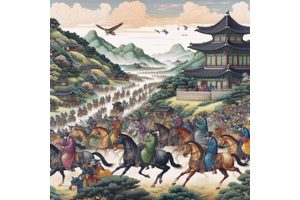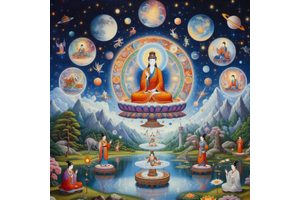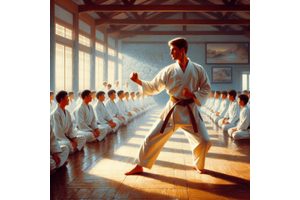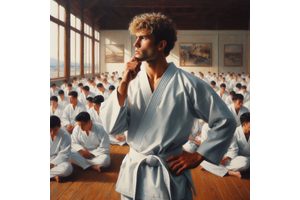The Yin-Yang Harmony
How Chon-Ji Balances Opposites
Chon-Ji, the first Taekwondo pattern, isn’t just a form—it’s a philosophy. It embodies the yin-yang harmony—the balance of opposites that governs the universe and ourselves. In this blog post, we’ll explore how Chon-Ji balances opposites, and how we can apply this balance to our martial arts and our daily lives.
1. What is the Yin-Yang Harmony?
The yin-yang harmony is a concept that originates from ancient Chinese philosophy. It describes how seemingly opposite or contrary forces are actually complementary, interconnected, and interdependent. The yin-yang symbol, also known as the Taegeuk, illustrates this harmony: Yin-Yang symbol
The symbol consists of two halves: a black half with a white dot, and a white half with a black dot. The black half represents yin, the feminine, passive, dark, and negative principle. The white half represents yang, the masculine, active, bright, and positive principle. The dots signify that each half contains a seed of the other, and that they are constantly transforming into each other. The curved shape implies that they are in constant motion and balance.
The yin-yang harmony teaches us that everything in the universe is composed of these two forces, and that they are essential for life and harmony. Without yin, there can be no yang, and vice versa. They are not absolute, but relative to each other. They are not static, but dynamic and changing. They are not in conflict, but in cooperation and balance.
2. How does Chon-Ji Balance Opposites?
Chon-Ji, the first Taekwondo pattern, embodies the yin-yang harmony in its name, movements, and symbolism. Let’s explore how:
- Name: Chon-Ji’s name translates to “Heaven” and “Earth”. It signifies the creation of the world or the dawn of human history. It also represents the balance we seek in both martial arts and life. Heaven and earth are opposites, but they are also complementary and interdependent. They form the basis of all existence, and they reflect the yin-yang harmony.
- Movements: Chon-Ji’s 19 movements balance opposites in various ways. For example, the pattern alternates between left and right, high and low, hard and soft, fast and slow, and offensive and defensive techniques. The pattern also balances different stances, such as walking stance, L-stance, and sitting stance. The pattern also balances different techniques; blocks, punches. The pattern also balances different directions, such as front, back, and side. The pattern also balances different levels of intensity, such as yelling (Ki-Hap or Chon-Ji) and silence. The pattern also balances different parts of the body, such as arms and legs, hands and feet, and head and torso. The pattern also balances different breathing patterns, such as inhaling and exhaling, and holding and releasing. The pattern also balances different emotions, such as calmness and aggression, confidence and humility, and joy and seriousness.
- Symbolism: Chon-Ji’s symbolism balances opposites in its meaning and application. For example, the pattern symbolises the creation of the world or the dawn of human history, which are opposites of destruction and end. The pattern also symbolises the balance we seek in life and combat, which are opposites of imbalance and harmony. The pattern also symbolises the balance of heaven and earth, which are opposites of aspiration and grounding, unattainable and attainable, and growth and stability.
3. How can we apply the Yin-Yang Harmony to our Martial Arts and our Daily Lives?
Chon-Ji teaches us to balance opposites in our martial arts and our daily lives. We can apply the yin-yang harmony to various aspects of our lives, such as:
- Martial Arts: In our martial arts practice, we can balance opposites by using different techniques, stances, and directions, depending on the situation and the opponent. We can also balance opposites by adjusting our speed, power, and intensity, depending on the purpose and the goal. We can also balance opposites by integrating our physical, mental, and spiritual aspects, depending on our needs and desires. We can also balance opposites by respecting our strengths and weaknesses, depending on our abilities and limitations. We can also balance opposites by cooperating and competing with our fellow practitioners, depending on our values and ethics.
- Daily Lives: In our daily lives, we can balance opposites by finding equilibrium in our work, relationships, and self-care, depending on our priorities and responsibilities. We can also balance opposites by being deliberate and flexible in our actions, depending on our plans and circumstances. We can also balance opposites by being resilient and adaptable in our challenges, depending on our resources and opportunities. We can also balance opposites by being humble and grateful in our achievements, depending on our efforts and outcomes. We can also balance opposites by being aspirational and grounded in our dreams, depending on our passions and realities.
Conclusion: The Universal Dance
Chon-Ji isn’t just a pattern/form—it’s a philosophy. It embodies the yin-yang harmony—the balance of opposites that governs the universe and ourselves. It teaches us to balance opposites in our martial arts and our daily lives, and to embrace the dynamic and changing nature of existence.
So, my fellow practitioners, next time you practice Chon-Ji, remember its meaning and significance. Feel the harmony of heaven and earth. And may your Taekwondo journey be as timeless as the stars.
Keep kicking, keep learning, and keep embracing the Chon-Ji spirit! ?????






